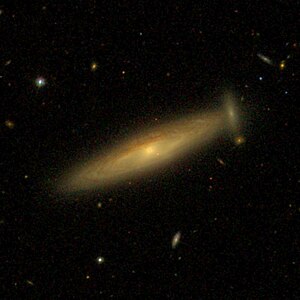NGC 217
| Galaxie NGC 217 | |
|---|---|
 | |
| LEDA 3368365, LEDA 2800505 (r.o.) & LEDA 2800509[1] (u) SDSS-Aufnahme | |
| AladinLite | |
| Sternbild | Walfisch |
| Position Äquinoktium: J2000.0, Epoche: J2000.0 | |
| Rektaszension | 00h 41m 33,9s[2] |
| Deklination | −10° 01′ 17″[2] |
| Erscheinungsbild | |
| Morphologischer Typ | SAB(rs)a / sp[2] |
| Helligkeit (visuell) | 12,6 mag[3] |
| Helligkeit (B-Band) | 13,5 mag[3] |
| Winkelausdehnung | 2,8′ × 0,6′[3] |
| Positionswinkel | 115°[3] |
| Flächenhelligkeit | 13,0 mag/arcmin²[3] |
| Physikalische Daten | |
| Zugehörigkeit | Abell 85 NGC 151-Gruppe LGG 8[2] |
| Rotverschiebung | 0,013116 ± 0,000007[2] |
| Radialgeschwindigkeit | (3932 ± 2) km/s[2] |
| Hubbledistanz H0 = 73 km/(s • Mpc) | (178 ± 12) · 106 Lj (54,6 ± 3,8) Mpc [2] |
| Durchmesser | 14.5000 Lj[4] |
| Geschichte | |
| Entdeckung | Wilhelm Herschel |
| Entdeckungsdatum | 28. November 1785 |
| Katalogbezeichnungen | |
| NGC 217 • PGC 2482 • MCG -02-02-085 • IRAS 00390-1017 • 2MASX J00413390-1001169 • GC 114 • H II 480 • h 48 • GALEXASC J004133.70-100116.0 • NSA 153631 | |
NGC 217 ist eine Spiralgalaxie vom Hubble-Typ SABa im Sternbild Walfisch südlich der Ekliptik. Sie ist schätzungsweise 178 Millionen Lichtjahre von der Milchstraße entfernt und hat einen Durchmesser von etwa 145.000 Lichtjahren.
Im selben Himmelsareal befindet sich u. a. die Galaxie NGC 195.
Das Objekt wurde am 28. November 1785 von dem deutsch-britischen Astronomen Wilhelm Herschel entdeckt.[5]
Weblinks
Einzelnachweise
Auf dieser Seite verwendete Medien
Autor/Urheber: Sloan Digital Sky Survey, Lizenz: CC BY 4.0

Angle of view: 4' × 4' (0.3" per pixel), north is up.
Details on the image processing pipeline: https://www.sdss.org/dr14/imaging/jpg-images-on-skyserver/